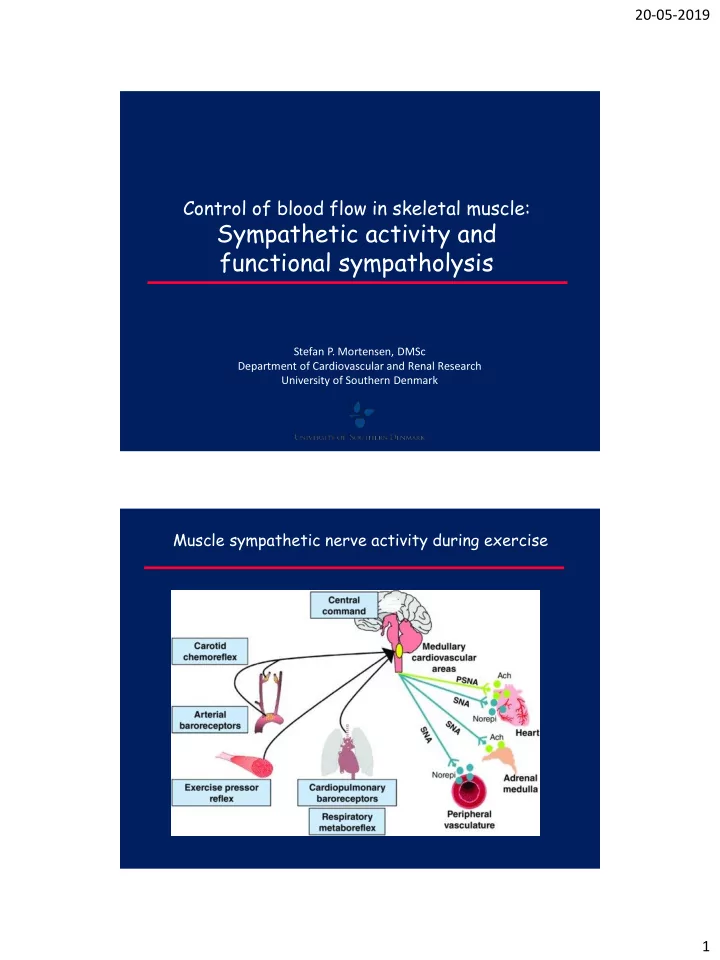

20-05-2019 Control of blood flow in skeletal muscle: Sympathetic activity and functional sympatholysis Stefan P. Mortensen, DMSc Department of Cardiovascular and Renal Research University of Southern Denmark Muscle sympathetic nerve activity during exercise 1
20-05-2019 Muscle sympathetic nerve activity during exercise Exercising muscle Resting muscle 20 Interstitial Norepinephrine * * 15 * * (nM) 10 5 0 Rest 18W 37W Recovery Mortensen et al. JAP 2009 Afferent signaling Sympathetic Vasocontriction Arteriole Contracting Muscle fiber NE Local vasoactive substances 2
20-05-2019 Functional sympatholysis Sympathetic Metabolites nerve ending NE a -receptor Smooth muscle O 2 Arteriole Functional sympatholysis – initial studies Rest Exercise 1 Exercise 2 Remensnyder et al. Circ Res. 1962 3
20-05-2019 Methods to increase SNA Lower body negative pressure Static and/or ischemic exercise Muscle sympathetic nerve activity 1400 4 1200 Leg blood flow (units min -1 ) 3 1000 Cold pressor (l min -1 ) 800 2 600 400 1 200 0 0 Leg ex Leg ex Leg ex + SHG + SHG + F I Strange JPhysiol 1999 Exercise and ATP-induced vasodilation overrides increases in vasoconstrictor activity Adenosine Tyramine ATP Exercise NE α 5 Leg blood flow 4 Leg (L/min) 3 blood flow (L/min) * 2 1 0 Rest Hyperemia Tyramine Rosenmeier et al . J Physiol 2004 4
20-05-2019 Tyramine induced norepinephrine release – effect of age Tyramine NE α Dinenno & Joyner Circ 2002 Tyramine induced norepinephrine release – effect of training status Tyramine NE α 20 Young men Sedentary elderly men Plasma norepinephrine Active elderly men 4 15 Normotensive subjects norepinephrine (mmol/l) Hypertensive subjects (nmol L -1 ) † ¤ Change in venous 3 † ¤ 10 ¤ ¤ 2 ¤ ¤ * 5 ¤ 1 ¤ † ¤ * 0 0 Rest 45% WL max 12 W Before training After training Mortensen et al. 2012 & 2014 5
20-05-2019 Exercise training improves functional sympatholysis 3.5 ¤ * * 3.0 § ¤ # * * * * Leg blood flow 0 2.5 (l/min) 2.0 ¤ 10 # % reduction in leg blood flow 1.5 1.0 20 ¤ 0.5 30 0.0 40 40 Leg vascular conductance 0 leg vascular conductance * 30 (ml/min/mmHg) * * 10 § % reduction in * * * # 20 20 10 30 0 40 Control leg Rest Exercise Exercise Exercise (24 W) Immobilized leg + tyramine Trained leg Mortensen et al. AJP 2012 Impaired functional sympatholysis with ageing Dinenno & Joyner 2005 6
20-05-2019 Impaired functional sympatholysis with ageing Young 4 Sedentary elderly * * * Active elderly * 3 Leg blood flow * † * (l*/min) * † ¤ * * * * † 2 * ¤ † 1 ¤ ¤ ¤ 0 Rest 45% WL max 12 W Mortensen et al . J Physiol 2012 Functional sympatholysis is impaired in the forearm of hypertensive patients Vongpatanosin et al. J Physiol 2012 7
20-05-2019 Functional sympatholysis is impaired in untrained normo- and hypertensive individuals and normalized with training Normotensive individuals Normotensive individuals with tyramine Hypertensive individuals Hypertensive individuals with tyramine Before training After training 35 Leg vascular conductance # 30 (ml/min/mmHg) # 25 # 20 # # 15 # 10 5 0 Rest 6W 12W 18W Rest 6W 12W 18W Exercise Exercise Functional sympatholysis in COPD 0.0 2.5 Change in leg blood flow 0.1 Healthy COPD 0.2 (l/min) 2.0 * 0.3 * Leg blood flow 1.5 0.4 (l/min) 0.5 1.0 0.5 Tyramine 0.0 10W 10W 10W + tyramine 10W 11 min 5 8 8
20-05-2019 Inefficient functional sympatholysis is an overlooked cause of malperfusion in contracting skeletal muscle? Functional sympatholysis Tissue perfusion SNA O 2 delivery Anaerobic metabolism Stimulation of afferent fibres Vongpatanosin et al. J Physiol 2012 Potential mediators of functional sympatholysis 9
20-05-2019 NO plays a role in mediating functional sympatholysis in rats Thomas & Victor JPhysiol 1998 Role of NO in functional sympatholysis Dinenno & Joyner JPhysiol 2003 Rosenmeier et al. JAP 2003 10
20-05-2019 Hearon et al. JPhysiol 2016 Role of ATP in functional sympatholysis Skeletal muscle cell NA ATP α Smooth Endothelial cells muscle muscle P2 ATP O 2 HbO 2 O 2 Hb O 2 O 2 O 2 O 2 Intraluminal space space Arterial vasculature Capillary 11
20-05-2019 Could interstitial ATP mediate functional sympatholysis? Young men Control leg Active elderly men Immobilized leg Sedentary elderly men Trained leg % reduction in leg vascular conductane % reduction in leg vascular conductane 0 0 5 10 10 20 15 30 20 40 0 2 4 6 8 10 0 1 2 3 4 5 6 Interstitial ATP Interstitial ATP (µmol/L) (µmol/L) Exercise training reduces postjunctional α -adrenergic vasoconstrictor responsiveness 0.0 0 4 conductance (ml/min/mmHg) Change in leg blood flow norepinephrine (mmol/l) Change in leg vascular -0.1 Change in venous 3 -1 -0.2 (l/min) -2 2 -0.3 ¤ ¤ -3 1 -0.4 0 -0.5 -4 Before training Before training After training After training Before training After training Normotensive subjects Hypertensive subjects Mortensen et al. J Physiol 2014 12
20-05-2019 Conclusions The ability for functional sympatholysis is tightly coupled to the training status of the muscle Functional sympatholysis is impaired with ageing Functional sympatholysis does not appear to be impaired in the leg of individuals with essential hypertension or COPD compared to age-matched controls Nitric oxide does not appear to be obligatory for functional sympatholysis in humans (but may play a role along with other substances) Reduced postjunctional α -adrenergic vasoconstrictor responsiveness may play a role in mediating functional sympatholysis Thank you for your attention! 13
Recommend
More recommend